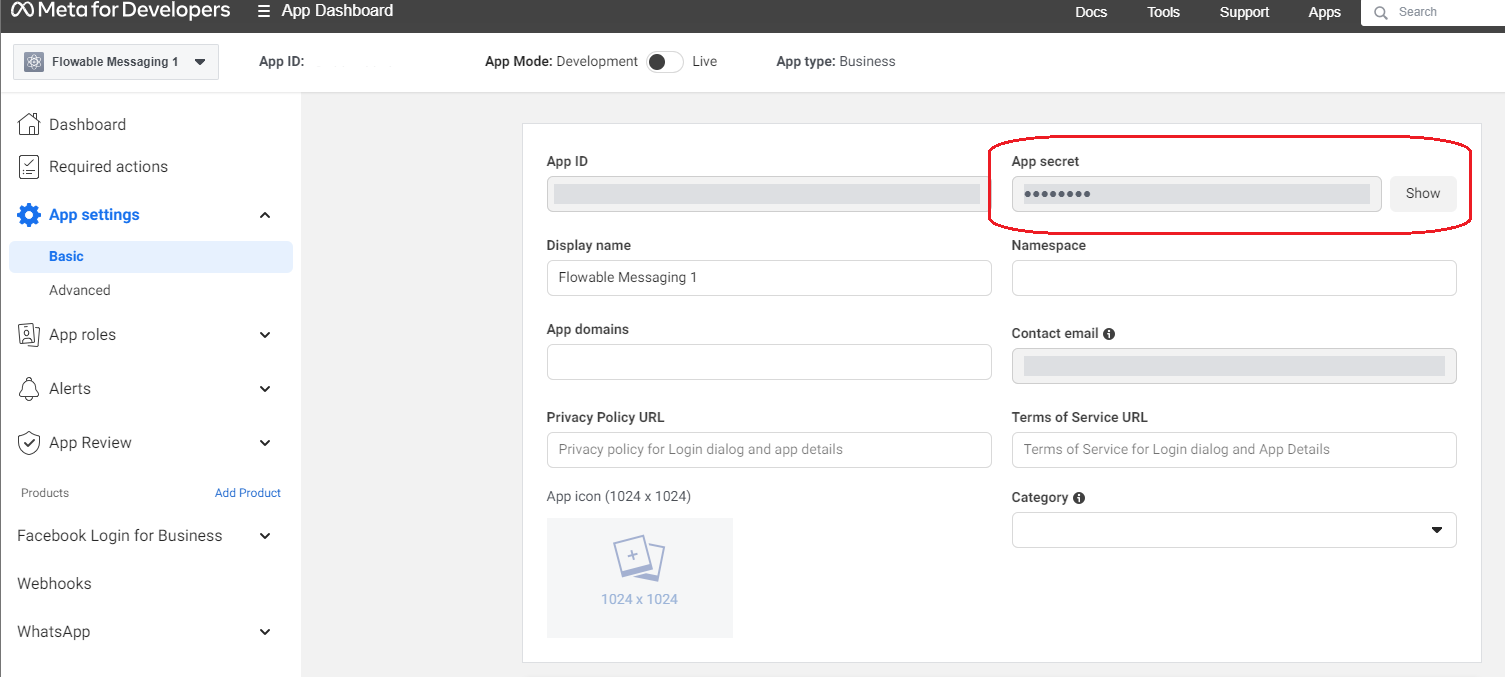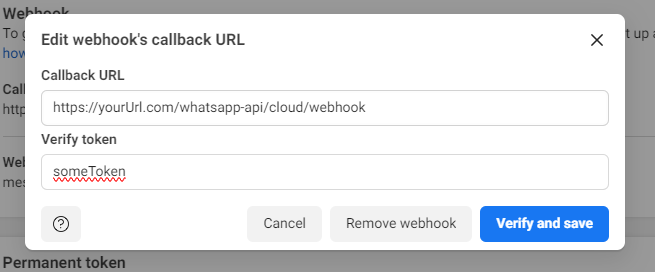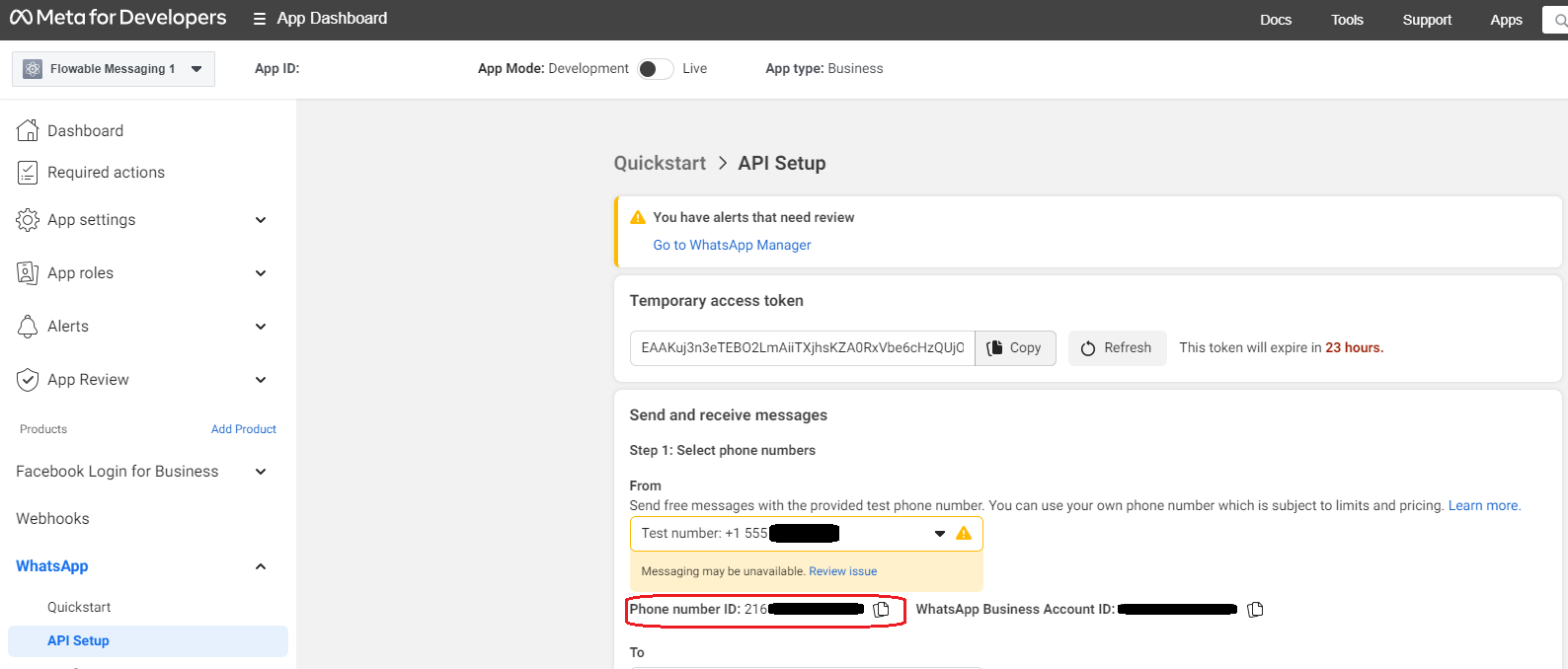Adapter Configuration
WhatsApp Adapter Configuration
The Flowable WhatsApp Adapter is able to run in a single account or multiple business accounts setup.
The WhatsApp on Premise support will expire on October 23, 2025. The adapter can be configured to run either with the WhatsApp Cloud API (v3.13.13+v3.14.7+v3.15.3+) or the On-Premise API
Single WhatsApp Business Account Configuration
Cloud API
v3.13.13+ v3.14.7+ v3.15.3+The WhatsApp Adapter needs to be configured via properties to connect to the WhatsApp Cloud API.
flowable.adapter.whatsapp.default-account-mode=cloud
flowable.adapter.whatsapp.default-api-endpoint=https://graph.facebook.com/v18.0/
flowable.adapter.whatsapp.default-api-webhook-verification-token=webhookVerificationToken
flowable.adapter.whatsapp.default-api-secret=appSecret
flowable.adapter.whatsapp.default-business-account-phone-number-id=BusinessPhoneNumberID
flowable.adapter.whatsapp.default-api-access-token=accessToken
And on the other side, the WhatsApp Developer Console, the webhook needs to be configured to send inbound messages to the WhatsApp Adapter with the following https endpoint: Visit that link
Webhook URLs = https://<<WhatsApp-Adapter-URL>>/whatsapp-api/cloud/webhook
Api Secret
You can find the secret in the WhatsApp Developer Console.

Since v3.13.13+v3.14.7+v3.15.4+ the api secret supports a list of string values. This feature facilitates seamless migration following the refresh of your WhatsApp app secret. New WhatsApp app secrets become valid after a specified period. To avoid longer downtime during the refresh, you can create a new WhatsApp app secret, configure the WhatsAppAdapter with the additional api secret and restart the adapter. After the time period, WhatsApp will stop sending signatures based on the old secret and will use the new secret.
Api Secret Expiry Date
Since v3.13.16+v3.14.9+v3.15.8+ you can provide a list of expiry dates for each secret.
While resetting an app secret, WhatsApp allows you to set a grace period before the old secret is obsolete. To mirror that behavior in the WhatsApp adapter,
we introduced the properties flowable.adapter.whatsapp.default-api-secret-expiry-dates and flowable.adapter.whatsapp.accounts.{accountName}.api-secret-expiry-dates.
Api secrets and expiry dates are mapped by index. If you provide more secrets than dates, those secrets will have no expiry date.
flowable.adapter.whatsapp.default-api-secret=oldSecret,newSecret
flowable.adapter.whatsapp.default-api-secret-expiry-dates=2024-07-02T12:15:00+02:00
In this configuration:
oldSecretwill expire on2024-07-02T12:15:00+02:00.newSecretwill not have any expiry date
If only one secret and one expiry date is provided, the date will not be taken into account.
Webhook Verification Token
You can pick whatever you want for your webhook verification token

API Access Token
Check out the WhatsApp documentation to create a permanent access token
Phone Number ID

On-Premise
The WhatsApp Adapter needs to be configured via properties to connect to the WhatsApp client On-Premise API.
flowable.adapter.whatsapp.default-account-mode=on-premise
flowable.adapter.whatsapp.default-api-endpoint=https://whatsapp-clientXY.flowable.io/
flowable.adapter.whatsapp.default-username=admin
flowable.adapter.whatsapp.default-password=secret_password
flowable.adapter.whatsapp.default-namespace=default_namespace
And on the other side, the WhatsApp Client needs to be configured to send inbound messages to the WhatsApp Adapter with the following http/https endpoint:
Webhook URLs = https://<<WhatsApp-Adapter-URL>>/whatsapp-api/webhook
For the single WhatsApp Business Account setup it is also important that the businessId is not set when creating a UserAccount in Flowable.
UserAccount userAccount = userAccountService.createNewUserAccountBuilder()
.name(name)
.userId(userId)
.externalUserId(externalUserId)
.businessAccountId(null)
.userAccountDefinitionKey(userAccountDefinitionKey)
.subType(subType)
.save();
Multiple WhatsApp Business Account Configuration
Also in the multiple WhatsApp Business Account setup the WhatsApp Adapter needs to be configured via properties.
For the configuration example, let's assume there are two WhatsApp Business Accounts your application needs to connect to, and let's call them flowable (cloud api) and mimacom (on premise api).
flowable.adapter.whatsapp.accounts.flowable.account-mode=cloud
flowable.adapter.whatsapp.accounts.flowable.api-endpoint=https://graph.facebook.com/v18.0/
flowable.adapter.whatsapp.accounts.flowable.api-webhook-verification-token=webhookVerificationToken
flowable.adapter.whatsapp.accounts.flowable.api-secret=appSecret
flowable.adapter.whatsapp.accounts.flowable.business-account-phone-number-id=BusinessPhoneNumberID
flowable.adapter.whatsapp.accounts.flowable.api-access-token=accessToken
flowable.adapter.whatsapp.accounts.mimacom.account-mode=on-premise
flowable.adapter.whatsapp.accounts.mimacom.api-endpoint=http://whatsapp-client.mimacom.io
flowable.adapter.whatsapp.accounts.mimacom.username=admin
flowable.adapter.whatsapp.accounts.mimacom.password=secret_mimacom_password
flowable.adapter.whatsapp.accounts.mimacom.namespace=mimacom_namespace
Cloud API
Now, on the WhatsApp Developer Console, the Webhook configuration needs to be configured based on the following pattern:
Webhook URLs = https://<<WhatsApp-Adapter-URL>>/whatsapp-api/cloud/webhook/account/<<account-id>>
On-Premise
Now, on the WhatsApp Client configuration, the Webhook configuration needs to be configured based on the following pattern:
Webhook URLs = https://<<WhatsApp-Adapter-URL>>/whatsapp-api/webhook/account/<<account-id>>
The <<account-id>> in our example would be flowable and mimacom and thus, the Webhook URL would be like following:
- For the flowable WhatsApp Client:
https://<<WhatsApp-Adapter-URL>>/whatsapp-api/cloud/webhook/account/flowable - For the mimacom WhatsApp Client:
https://<<WhatsApp-Adapter-URL>>/whatsapp-api/webhook/account/mimacom
For the multiple WhatsApp Business Account setup it is important that the businessAccountId of the UserAccount reflects the WhatsApp Business Account the UserAccount is interacting with.
UserAccount userAccount = userAccountService.createNewUserAccountBuilder()
.name(name)
.userId(userId)
.externalUserId(externalUserId)
.businessAccountId(accountId)
.userAccountDefinitionKey(userAccountDefinitionKey)
.subType(subType)
.save();
Also here, the accountId variable needs to reflect the Whatsapp Account ID and thus, in our example flowable or mimacom.
If the businessAccountId is empty, then the UserAccount interacts with the default-api-endpoint as described in the Single WhatsApp Business Account configuration above.
WhatsApp Adapter Content Handling Configuration
To work with media messages, i.e. attachments send through WhatsApp, the following properties need to be configured in the WhatsApp Adapter:
flowable.adapter.content.enabled=true
flowable.adapter.content.rest-endpoint=http://<hostname of Flowable>/<application root>/content-api/
flowable.adapter.content.admin-username=<admin username>
flowable.adapter.content.admin-password=<admin password>
flowable.adapter.whatsapp.content-authorization=Basic Zmxvd2FibGU6bWltYWNvbQ==
flowable.adapter.whatsapp.receive-content-max-size=-1
The property flowable.adapter.content.enabled enables the servlet for content handling.
The credentials provided in flowable.adapter.content.admin-username and flowable.adapter.content.admin-password are used to access the
content endpoint in Flowable defined in flowable.adapter.content.rest-endpoint.
This applies to the default security configuration with Basic Authentication in Flowable. If you have a custom authentication like Kerberos or OAuth2, you need to customize the WebClient in the WhatsApp Adapter to use the same authentication.
The property flowable.adapter.whatsapp.content-authorization secures the content REST endpoint in the WhatsApp
adapter by the chosen authorization (in the above example it’s a base64 encoded basic authentication with username
flowable and password mimacom).
This must be in sync with the credentials configured in flowable.external-system.whatsapp.content.rest-username and flowable.external-system.whatsapp.content.rest-password
in Flowable (see below).
The flowable.adapter.whatsapp.receive-content-max-size can be used to limit the content data size when receiving
WhatsApp content (by default it is set to -1, which means unlimited).
After this has been set, then the REST endpoint will be available with the configured authorization:
GET https://<<WhatsApp-Adapter-URL>>/whatsapp-api/content/<<content-id>>“.
Additionally, the Flowable application requires the following properties to be set in order to fetch the message attachments from the WhatsApp adapter.
The credentials must match the ones used to create the base64 token in flowable.adapter.whatsapp.content-authorization:
flowable.external-system.whatsapp.content.base-content-url=http://<hostname of WhatsApp Adapter>:<port>/whatsapp-api/content/
flowable.external-system.whatsapp.content.rest-username=<admin username>
flowable.external-system.whatsapp.content.rest-password=<admin password>
These configurations enable content, i.e. all other supported message types in addition to text, to be retrieved from WhatsApp. See WhatsApp Message Type Configuration to configure the supported WhatsApp message types.
WhatsApp Adapter Additional Configuration
The WhatsApp Adapter is a Spring Boot application and can be configured by the following properties.
server.port=31331
flowable.adapter.whatsapp.webhook-servlet-path=/whatsapp-api
flowable.adapter.whatsapp.webhook-load-on-startup=-1
spring.activemq.broker-url=tcp://localhost:61616
It runs by default on port 31331 and creates a webhook servlet on the path whatsapp_api. The Servlet is lazy-loaded by default, but if no lazy loading is desired, this can be configured by flowable.adapter.whatsapp.webhook-load-on-startup=1.
The WhatsApp Adapter uses an ActiveMQ broker for the following inbound and outbound queues (which can be reconfigured to your own requirements).
flowable.adapter.whatsapp.jms.inbound-payload-destination=whatsapp-inbound-payload
flowable.adapter.whatsapp.jms.inbound-message-destination=whatsapp-inbound
flowable.adapter.whatsapp.jms.inbound-status-destination=whatsapp-inbound-status
flowable.adapter.whatsapp.jms.inbound-error-destination=whatsapp-inbound-error
flowable.adapter.whatsapp.jms.outbound=whatsapp-outbound
flowable.adapter.whatsapp.jms.send-message-wait-duration=PT10S
If the default queue names are changed in the WhatsApp Adapter, it is necessary to also change the Flowable configuration to match the queue names. This can be achieved by the Flowable properties described here.
WeChat Adapter Configuration
The Flowable WeChat Adapter is able to run in a single account or multiple business accounts setup.
Single WeChat Business Account Configuration
The WeChat Adapter needs to be configured via properties to connect to the WeChat Business Account.
flowable.adapter.wechat.default-app-id=<<<WeChat-App-ID>>>
flowable.adapter.wechat.default-app-secret=<<<WeChat-App-Secret>>>
flowable.adapter.wechat.default-app-token=<<<WeChat-App-Token>>>
flowable.adapter.wechat.default-aes-key=<<<WeChat-Aes-Key>>>
And on the other side, the WeChat Business Account needs to be configured to send inbound messages to the WeChat Adapter using the following http/https endpoint:
Webhook URLs = https://<<WeChat-Adapter-URL>>/wechat-api/webhook
For the single WeChat Business Account setup it is also important that the businessId is not set when creating a UserAccount in Flowable.
UserAccount userAccount = userAccountService.createNewUserAccountBuilder()
.name(name)
.userId(userId)
.externalUserId(externalUserId)
.businessAccountId(null)
.userAccountDefinitionKey(userAccountDefinitionKey)
.subType(subType)
.save();
Multiple WeChat Business Account Configuration
In the multiple WeChat Business Account setup, the WeChat Adapter needs to be configured via properties.
For the configuration example let's assume there are two WeChat Business Accounts your application needs to connect to, and let's call them flowable and mimacom.
flowable.adapter.wechat.accounts.flowable.app-id=<<<WeChat-App-ID for flowable>>>
flowable.adapter.wechat.accounts.flowable.app-secret=<<<WeChat-App-Secret for flowable>>>
flowable.adapter.wechat.accounts.flowable.app-token=<<<WeChat-App-Token for flowable>>>
flowable.adapter.wechat.accounts.flowable.aes-key=<<<WeChat-Aes-Key for flowable>>>
flowable.adapter.wechat.accounts.mimacom.app-id=<<<WeChat-App-ID for mimacom>>>
flowable.adapter.wechat.accounts.mimacom.app-secret=<<<WeChat-App-Secret for mimacom>>>
flowable.adapter.wechat.accounts.mimacom.app-token=<<<WeChat-App-Token for mimacom>>>
flowable.adapter.wechat.accounts.mimacom.aes-key=<<<WeChat-Aes-Key for mimacom>>>
Now, on the WeChat Business Account configuration the Webhook configuration needs to be configured based on the following pattern:
Webhook URLs = https://<<WeChat-Adapter-URL>>/wechat-api/webhook/account/<<account-id>>
The <<account-id>> in our example would be flowable and mimacom and thus, the Webhook URL would be like following:
- For the flowable WeChat Business Account:
https://<<WeChat-Adapter-URL>>/wechat-api/webhook/account/flowable - For the mimacom WeChat Business Account:
https://<<WeChat-Adapter-URL>>/wechat-api/webhook/account/mimacom
For the multiple WeChat Business Account setup it is important that the businessAccountId of the UserAccount reflects the WeChat Business Account the UserAccount is interacting with.
UserAccount userAccount = userAccountService.createNewUserAccountBuilder()
.name(name)
.userId(userId)
.externalUserId(externalUserId)
.businessAccountId(accountId)
.userAccountDefinitionKey(userAccountDefinitionKey)
.subType(subType)
.save();
Also here, the accountId variable needs to reflect the WeChat Account id and thus, in our example flowable or mimacom.
If the businessAccountId is empty, then the UserAccount interacts with the default-app-* as described in the Single WeChat Business Account configuration above.
WeChat Adapter Content Handling Configuration
To work with media messages, i.e. attachments send through WeChat, the following properties need to be configured in the WeChat Adapter:
flowable.adapter.content.enabled=true
flowable.adapter.content.rest-endpoint=http://<hostname of Flowable>/<application root>/content-api/
flowable.adapter.content.admin-username=<admin username>
flowable.adapter.content.admin-password=<admin password>
flowable.adapter.wechat.content-authorization=Basic Zmxvd2FibGU6bWltYWNvbQ==
flowable.adapter.wechat.receive-content-max-size=-1
The property flowable.adapter.content.enabled enables the servlet for content handling.
The credentials provided in flowable.adapter.content.admin-username and flowable.adapter.content.admin-password are used to access the
content endpoint in Flowable defined in flowable.adapter.content.rest-endpoint.
This applies to the default security configuration with Basic Authentication in Flowable. If you have a custom authentication like Kerberos or OAuth2, you need to customize the WebClient in the WeChat Adapter to use the same authentication.
The property flowable.adapter.wechat.content-authorization secures the content REST endpoint in the WeChat
adapter by the chosen authorization (in the above example it’s a base64 encoded basic authentication with username
flowable and password mimacom).
This must be in sync with the credentials configured in flowable.external-system.wechat.content.rest-username and flowable.external-system.wechat.content.rest-password
in Flowable (see below).
The flowable.adapter.wechat.receive-content-max-size can be used to limit the content data size when receiving
WeChat content (by default it is set to -1, which means unlimited).
After this has been set, then the REST endpoint will be available with the configured authorization:
GET https://<<WeChat-Adapter-URL>>/wechat-api/content/<<content-id>>“.
Additionally, the Flowable application requires the following properties to be set in order to fetch the message attachments from the WeChat adapter.
The credentials must match the ones used to create the base64 token in flowable.adapter.wechat.content-authorization:
flowable.external-system.wechat.content.base-content-url=http://<hostname of WeChat Adapter>:<port>/wechat-api/content/
flowable.external-system.wechat.content.rest-username=<admin username>
flowable.external-system.wechat.content.rest-password=<admin password>
These configurations enable content, i.e. all other supported message types in addition to text, to be retrieved from WeChat. See WeChat Message Type Configuration to configure the supported WeChat message types.
WeChat Adapter Additional Configuration
The WeChat Adapter is a Spring Boot application and can be configured by the following properties.
server.port=31330
flowable.adapter.wechat.webhook-servlet-path=/wechat-api
flowable.adapter.wechat.webhook-load-on-startup=-1
spring.activemq.broker-url=tcp://localhost:61616
It runs by default on port 31330 and creates a webhook servlet on the path wechat_api. The Servlet is lazy-loaded by default, but if no lazy loading is desired, this can be configured by flowable.adapter.whatsapp.webhook-load-on-startup=1.
The WeChat Adapter uses an ActiveMQ broker for the following inbound and outbound queues (which can be reconfigured to your own requirements).
flowable.adapter.wechat.jms.inbound-message-destination=wechat-inbound
flowable.adapter.wechat.jms.inbound-status-destination=wechat-inbound-status
flowable.adapter.wechat.jms.inbound-error-destination=wechat-inbound-error
flowable.adapter.wechat.jms.outbound=wechat-outbound
flowable.adapter.wechat.jms.get-access-token-destination=wechat-get-access-token
flowable.adapter.wechat.jms.store-access-token-destination=wechat-store-access-token
flowable.adapter.wechat.jms.send-message-wait-duration=PT10S
If the default queue names are changed in the WeChat Adapter, it is necessary to also change the Flowable configuration to match the queue names. This can be achieved by the Flowable properties described here.
Furthermore, the WeChat API endpoints and more connectivity configuration can be addressed by the following properties:
flowable.adapter.wechat.api.base-url=https://api.weixin.qq.com/cgi-bin/
flowable.adapter.wechat.api.token-url=https://api.weixin.qq.com/cgi-bin/token
flowable.adapter.wechat.api.user-profile-url=https://api.weixin.qq.com/cgi-bin/user/info
flowable.adapter.wechat.api.custom-message-url=https://api.weixin.qq.com/cgi-bin/message/custom/send
flowable.adapter.wechat.api.template-message-url=https://api.weixin.qq.com/cgi-bin/message/template/send
flowable.adapter.wechat.unsupported-message-type-error=
flowable.adapter.wechat.user-profile-fetching=true
flowable.adapter.wechat.default-user-name=Unknown
flowable.adapter.wechat.secure-communication=false
LINE Adapter Configuration
The Flowable LINE Adapter is able to run in a single account or multiple business accounts setup.
Single LINE Business Account Configuration
The LINE Adapter needs to be configured via properties to connect to the LINE Messaging API Bot Channel.
flowable.adapter.line.default-channel-secret=<<<LINE-Channel-Secret>>>
flowable.adapter.line.default-channel-token=<<<LINE-Channel-Token>>>
And on the other side, the LINE Messaging API Bot Channel needs to be configured to send inbound messages to the LINE Adapter with the following https endpoint:
Webhook URL = https://<<LINE-Adapter-URL>>/line-api/webhook
For the single LINE Business Account setup it is also important that the businessId is not set when creating a UserAccount in Flowable.
UserAccount userAccount = userAccountService.createNewUserAccountBuilder()
.name(name)
.userId(userId)
.externalUserId(externalUserId)
.businessAccountId(null)
.userAccountDefinitionKey(userAccountDefinitionKey)
.subType(subType)
.save();
Multiple LINE Business Account Configuration
Also in the multiple LINE Business Account setup the LINE Adapter needs to be configured via properties.
For the configuration example, let's assume there are two LINE Business Accounts your application needs to connect to, and let's call them flowable and mimacom.
flowable.adapter.line.accounts.flowable.channel-secret=<<<LINE-Flowable-Channel-Secret>>>
flowable.adapter.line.accounts.flowable.channel-token=<<<LINE-Flowable-Channel-Token>>>
flowable.adapter.line.accounts.mimacom.channel-secret=<<<LINE-Mimacom-Channel-Secret>>>
flowable.adapter.line.accounts.mimacom.channel-token=<<<LINE-Mimacom-Channel-Token>>>
Now, on the LINE Messaging API Bot Channel configuration, the Webhook configuration needs to be configured based on the following pattern:
Webhook URLs = https://<<LINE-Adapter-URL>>/line-api/webhook/account/<<account-id>>
The <<account-id>> in our example would be flowable and mimacom and thus, the Webhook URL would be like following:
- For the flowable LINE Bot Channel:
https://<<LINE-Adapter-URL>>/line-api/webhook/account/flowable - For the mimacom LINE Bot Channel:
https://<<LINE-Adapter-URL>>/line-api/webhook/account/mimacom
For the multiple LINE Business Account setup it is important that the businessAccountId of the UserAccount reflects the LINE Business Account the UserAccount is interacting with.
UserAccount userAccount = userAccountService.createNewUserAccountBuilder()
.name(name)
.userId(userId)
.externalUserId(externalUserId)
.businessAccountId(accountId)
.userAccountDefinitionKey(userAccountDefinitionKey)
.subType(subType)
.save();
Also here, the accountId variable needs to reflect the LINE Account ID and thus, in our example flowable or mimacom.
If the businessAccountId is empty, then the UserAccount interacts with the default-api-endpoint as described in the Single LINE Business Account configuration above.
LINE Adapter Content Handling Configuration
To work with media messages, i.e. attachments send through LINE, the following properties need to be configured in the LINE Adapter:
flowable.adapter.content.enabled=true
flowable.adapter.content.rest-endpoint=http://<hostname of Flowable>/<application root>/content-api/
flowable.adapter.content.admin-username=<admin username>
flowable.adapter.content.admin-password=<admin password>
flowable.adapter.line.content-authorization=Basic Zmxvd2FibGU6bWltYWNvbQ==
flowable.adapter.line.receive-content-max-size=-1
flowable.adapter.line.jms.engage-rest-endpoint=http://<hostname of Flowable>/<application root>/engage-api/
The property flowable.adapter.content.enabled enables the servlet for content handling.
The credentials provided in flowable.adapter.content.admin-username and flowable.adapter.content.admin-password are used to access the
content endpoint in Flowable defined in flowable.adapter.content.rest-endpoint.
This applies to the default security configuration with Basic Authentication in Flowable. If you have a custom authentication like Kerberos or OAuth2, you need to customize the WebClient in the LINE Adapter to use the same authentication.
The property flowable.adapter.line.content-authorization secures the content REST endpoint in the LINE
adapter by the chosen Authorization (in the above example it’s a base64 encoded Basic Authentication with username
flowable and password mimacom).
This must be in sync with the credentials configured in flowable.external-system.line.content.rest-username and flowable.external-system.line.content.rest-password
in Flowable (see below).
The flowable.adapter.line.receive-content-max-size can be used to limit the content data size when receiving
LINE content (by default it is set to -1, which means unlimited).
The property flowable.adapter.line.jms.engage-rest-endpoint points to the location of the Engage API where the special LineOutboundContentResource is located.
When this property is not set then sending content from Flowable to LINE is not possible.
The way outbound content (from Flowable to LINE) works a bit differently than WhatsApp. For WhatsApp we upload the content to the WhatsApp servers and then send a message with the content id. However, LINE does not support such functionality. Therefore, we have to provide publicly accessible URLs for accessing the content from the user device. The
LineOutboundContentResourceis needed for this exact reason. In order to access the content we generate a special token secured with the specific Flowable properties that allows accessing that particular content through a special API for a configurable time.
After this has been set, then the REST-Endpoint will be available with the configured Authorization:
GET https://<<LINE-Adapter-URL>>/line-api/content/<<content-id>>“.
Additionally, the Flowable application requires the following properties to be set in order to fetch and serve the message attachments from the LINE adapter:
flowable.external-system.line.content.base-content-url=http://<hostname of LINE Adapter>:<port>/line-api/content/
flowable.external-system.line.content.rest-username=<admin username>
flowable.external-system.line.content.rest-password=<admin password>
flowable.external-system.line.outbound-content.enabled=true
flowable.external-system.line.outbound-content.base-content-public-url=https://<publicly accessible LINE Adapter URL>/line-api
flowable.external-system.line.outbound-content.content-token-signing-secret=<custom secret with a length of at least 32 characters>
# How long should the outbound content token be valid
flowable.external-system.line.outbound-content.content-token-expiration-duration=PT1
These configurations enable content, i.e. all other supported message types in addition to text, to be retrieved from LINE. It also allows sending content to LINE by exposing the content through publicly accessible URLs with special token handling.
LINE Adapter Additional Configuration
The LINE Adapter is a Spring Boot application and can be configured by the following properties.
server.port=31332
flowable.adapter.line.webhook-servlet-path=/line-api
flowable.adapter.line.webhook-load-on-startup=-1
spring.activemq.broker-url=tcp://localhost:61616
It runs by default on port 31332 and creates a webhook servlet on the path line_api. The Servlet is lazy-loaded by default, but if no lazy loading is desired, this can be configured by flowable.adapter.line.webhook-load-on-startup=1.
The LINE Adapter uses an ActiveMQ broker for the following inbound and outbound queues (which can be reconfigured to your own requirements).
flowable.adapter.line.jms.inbound-payload-destination=line-inbound-payload
flowable.adapter.line.jms.inbound-message-destination=line-inbound
flowable.adapter.line.jms.inbound-status-destination=line-inbound-status
flowable.adapter.line.jms.inbound-error-destination=line-inbound-error
flowable.adapter.line.jms.outbound=line-outbound
flowable.adapter.line.jms.send-message-wait-duration=PT10S
If the default queue names are changed in the LINE Adapter, it is necessary to also change the Flowable configuration to match the queue names. This can be achieved by the Flowable properties described here.